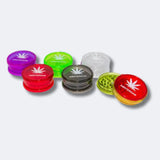
Make your own CAL/MAG fertilizer
Andreas LeschkeShare blog post
Make your own organic calcium/magnesium fertilizer (CAL/MAG).
First of all, I would like to emphasize that CAL/MAG fertilizer is an organic type of fertilizer that should only be used in cases of calcium and magnesium deficiencies.
The CAL/MAG fertilizer is a pure "Frest Aid" fertilizer that is used to save your plants when the soil no longer has sufficient calcium and magnesium to supply their foliage, causing brown spots and spots on healthy leaves that then die within a few days.
If the plant signals a deficiency through its leaves, action should be taken quickly and effectively. You can either purchase a so-called "CAL/MAG" fertilizer online or from a grow shop, or you can make it yourself using very few household ingredients.
To make your own calcium and magnesium fertilizer, all you need are eggshells, Epsom salts, and water!
That's really all that's needed. Although there are other recipes with additional additives, Cal/Mag is simply about supplying our plant with calcium and magnesium.

Those who like to make their own homemade fertilizers and who use eggs always dry some eggshells to make fertilizer for plants. The advantage is that dry eggshells are much easier to "pulverize" with a pestle or meat tenderizer than fresh eggshells.
While eggshells provide the calcium source for our homemade fertilizer, we also need a source of magnesium. Eggshells contain a small amount of magnesium, but unfortunately, it's not enough to provide the required calcium-to-magnesium balance.
Therefore, we need a magnesium source as our second component. This is provided by Epsom salts, which can be purchased for a few euros at pharmacies, hardware stores, and some discount stores, so it's quickly available.
We make our own Cal/Mag fertilizer by crushing six eggshells until they're powdery and granular. At the same time, we place a pot of 2 liters of water on the stove and let it boil.
Once the water is boiling and simmering, add the crushed eggshell pile to the boiling water and add approximately 15 g of Epsom salt (approximately 1 tablespoon). The broth is then stirred continuously for approximately 5-10 minutes while it boils, ensuring constant movement in the pot.

This completes the preparations and we can remove the pot from the stove, cover it with a towel and let it steep for 24 hours.
After 24 hours, the fertilizer is filtered through a kitchen sieve and bottled.
This solution can then be poured directly into the soil and also sprayed onto the leaves or the entire plant using spray bottles.
If a CAL/MAG deficiency is detected quickly, you'll definitely not need 2 liters. Therefore, I recommend bottling any unused fertilizer and storing it in a cool, dark place. This way, the fertilizer will last for about 3 months.
For non-vegans who enjoy eating eggs, this homemade fertilizer represents a huge cost advantage over store-bought CAL/MAG fertilizers.
Store-bought calcium/magnesium fertilizer costs about €5 for 250 ml, while homemade fertilizer requires only kitchen scraps (eggshells) and, for 2 liters of ready-made fertilizer, Epsom salts worth €0.10. Apart from the two liters of water, nothing else is needed.
How, when, and how often you should apply Cal/Mag fertilizers and what you should keep in mind will be discussed in my next blog post when we take a closer look at the different types of cannabis fertilizers and boosters to cultivate a vital and strong wonder plant.
We thank the author Jorge Rieger for this blog post on making your own CAL/MAG fertilizer. Feel free to follow him on his Facebook account. --> Click here







5 comments
Kann ich auch ein wenig normales grobes küchen salz benutzen danke im voraus.
Nachtrag an @Michi:
Warum ich für Cal/Mag Dünger NIEMALS Essig verwenden würde.
Der CAL/MAG Mangel tritt am Häufigsten in der Blüteperiode auf. Es ist einer Unverträglichkeit des LED-Lichts geschuldet.
In der Blütephase benötigen unsere Ladies einen PH-Wert für die Vorblüte von 6,0 – 6,2 im Nährboden und in der Vollblüte einen PH-Wert von 6,2 – 6,5!
Mit Essig senkst Du massiv den PH-Wert, so dass er ganz schnell bei unter 6 gelangt. Diesen müsstest Du wieder anheben!
Essig wäre somit ein wahrer PH Killer für den Nährboden und daher in der Blütephase kaum empfehlenswert.
Solltest Du dennoch Essig verwenden wollen, achte daher bitte auf den PH-Wert des Nährbodens, denn Du anschließend dann wieder nach oben regulieren müsstest.
@Michi:
“Wie sicher bist Du, dass die zerkleinerten Eierschalen wirklich ausreichend Pflanzenverfügbares Kalzium freigeben?”
Zu 100% sicher, auch wenn ich kein TDS-Messer in den Cal/Mag Flüssigdünger gehalten habe. Ich habe die Erfahrung gemacht, dass wenn ich meine Pflanzen von Anbeginn an damit behandle, es zu keinerlei Cal/Mag Mangel überhaupt kommt. Gerade bei sehr LED-empfindlichen Strains, wie z.B. die Mango Smile ist ohne den Cal/Mag Dünger am Ende der Blütezeit immer ein Mangel feststellbar gewesen. Wenn ich mit diesem Dünger regelmäßig die Mango Smile versorgt hatte, traten keinerlei Mängel auf.
“Habe gehört, dass dieses Kalzium besser oder überhaupt erst als Ion Pflanzenverfügbar sei, wenn es durch Essig aus den Schalen herausgelöst wurde.”
Ja, das glaube ich Dir. Man hört vieles. Vieles ist richtig und vieles ist falsch. Fakt ist, Du brauchst kein Essig, da dass heiße Wasser in dem Du die Mischung rührst, während des Koch- und Rührvorgang sämtliche Mineralien aus der Schale löst, die dann ins Wasser übergehen.
Der Kochvorgang, inkl dem Rühren und dem 24h ziehen lassen sorgen dafür, dass sich das Kalzium aus den Schalen löst!
Es funktioniert zu 100%.
Probiere es daher ruhig selbst aus, Du hast nichts zu verlieren!
Denn nur die praktische Erfahrung macht uns schlauer und nicht, was man so alles “hört”.
Wie sicher bist Du, dass die zerkleinerten Eierschalen wirklich ausreichend Pflanzenverfügbares Kalzium freigeben?
Habe gehört, dass dieses Kalzium besser oder überhaupt erst als Ion Pflanzenverfügbar sei, wenn es durch Essig aus den Schalen herausgelöst wurde. Hast Du Du vllt mal ein TDS-Meter in die Eierschalen-Mixtur gehalten?
LG!
Danke für dein hilfreich Blog.